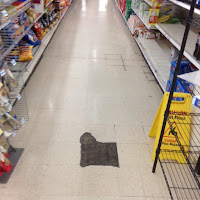The Christmas shopping season is underway. Shoppers were out in force at the local stores I visited this afternoon‚ not in the large numbers of a November weekend, but enough to tell you this is not just an ordinary shopping weekend. Shoppers converged on the checkouts to form the same kind of lines that will be seen with a larger number of cash registers open a month from now.
The strong early start to the Christmas shopping season implies that, like the past six or years, the crush in November and early December may never materialize. For troubled retailers hoping for a big December, like Mattress Firm, Barnes & Noble, and of course, the newly bankrupt Sears and Kmart, the high level of activity in October is not a favorable sign. It implies that December will again be on the sluggish side, with many shoppers having already completed their shopping by then.
One of the stores I visited was the local Kmart store that is set to shut down in bankruptcy in about ten weeks. There were plenty of shoppers in the store even though the store closing sale will probably be starting in about another week. Looking at the store, the only indication of a liquidation underway was a small display of back-to-school items at a deep discount. It was, as they always say in bankruptcy, business as usual.
The shelves were stocked well enough to be credible, but if you looked for them, you could see signs of a business in decline. The company had stopped repairing the floor at least two years back. The ceiling banner that said “Introducing Craftsman,” a marketing message that dates all the way back to the original merger of Sears and Kmart, had surely not been touched in more than ten years.
The merchandise selection, when I looked at it, seemed somewhat dated, though walking into Kmart was not like walking into a time machine. The wall of televisions one might have seen a decade ago is gone, and there are now more iPhone cases for sale than televisions in the electronics section.
It was my first visit to Kmart in about five months, and looking at the items on the shelves I realized why. The specific item I had come to buy, an appliance extension cord, was the kind of item that could be expected to last for 20 to 50 years. Extension cords do not wear out the same way they once did. The same holds true of a wide range of merchandise. One aisle over, there were LED light bulbs that might last half of a human lifetime, right next to the more familiar incandescent bulbs that last about one year. Shoppers who select the LED bulbs, even by accident, will not be back to the same display nearly so soon. At the front of the store, artificial Christmas trees showed the same kind of durable design that might last for decades.
The layout and business model of the traditional department store, which Kmart replicates, is based on the assumption that common items like extension cords will be replaced every few years. With so many items to replace, you return to the store almost every month. There was a time when that theory worked. I remember when I would shop in a department store at least once a month. Without my noticing, that became once or twice a year. The durability of modern manufactured goods is what is killing the department store. I have written about shopping fatigue, consumer time pressure, and e-commerce, and surely these all have their impact, but product durability is the crux of the problem that faces department stores. This implies that the failure and likely liquidation of Sears and Kmart is not good news for Target, Walmart, or Amazon. When products last longer, every retailer has fewer opportunities to sell.


